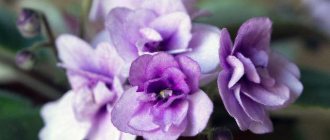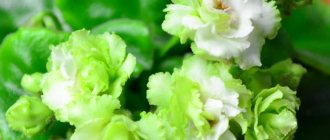Description of the White Queen species
Features and differences from other types of violets
I think that the White Queen violet has a snow-white color is already obvious. Violet is also distinguished by larger flowers, lush flowering and slow rosette growth.
Leaves
The diameter of the rosette is 25-30 cm. During flowering, the rosette is almost completely covered by lush flowers. The leaves have a pleasant green color with a slight shine. The edges of the leaves have a wavy and pointed shape. With age, the cuttings become more rigid and therefore break easily.
Flowers
The flowers are large and lush, so large that the peduncle The peduncle is the upper part of the stem on which the inflorescence grows. At the initial stages of development in orchids, it is difficult to distinguish the peduncle from the root. Here are some differences: • bends under their weight. The diameter of each flower ranges from 7 to 7.5 cm. The White Queen species blooms in approximately 2 months. Flowering lasts up to two weeks. Sometimes the violet may change color. Most often this happens during hot periods. The petals may turn pink and your White Queen may turn Pink.
Saintpaulia Rosemary
The star-shaped, double flowers of the LE Rosemary violet, the photo of which is presented here, will become a luxurious decoration for any collection. The variety, bred by E. Lebetskaya, combines several bright, memorable features. Not only are the notched petals gracefully corrugated, but pink strokes and abundant blue splashes look amazing against a white background. Rosemary violet is a standard-sized plant with a rosette of dark green, toothed leaves.
Caring for violets at home
Lighting
To get large blooms, you need to keep the White Queen violet on the window. This variety does not respond well to artificial lighting, but direct sunlight will also be destructive. Western or eastern windows are well suited for growing the White Queen. In very sunny weather, it is advisable to shade the violet. If the lighting rules are violated, the violet will not be able to produce as many lush blooms.
Temperature
The optimal temperature for growing White Queen violets is 20-22 degrees. Maintaining this temperature regime at home is not difficult. If the temperature is very high, the violet may lose its white color and begin to take on a pink tint.
Humidity
Air humidity is standard for most violets, namely 50-60%. It is not advisable to use a sprayer to increase humidity. Spots may appear on the leaves, and rot will begin to multiply. A good option would be a container of water. Just install it next to the plant. The water will gradually evaporate and fill the air with moisture.
Watering the White Queen violet
The most important thing when watering is to be moderate. The White Queen violet does not tolerate waterlogging very well. The roots begin to rot and the flower may die. At the same time, everyone needs to water regularly. You can also use regular tap water. But it is desirable that it be settled. Of course, one of the best options would be rain or melt water. There are three methods of watering, top, bottom and wick.
The top method is the simplest and least troublesome. Carefully pour water into the edge of the pot. Do not allow water to get on the leaves or in the center of the rosette. If this does happen, remove the water with a napkin.
When watering from below, you need to place the flower pot in a container of water. Water should cover two thirds of the pot. The procedure should be completed when the surface of the soil begins to shine. On average, this should take 20 minutes. Wick watering is very convenient if everything is set up correctly. A cord with a diameter of 3-5 mm should be placed in the soil of the flower. The end must be passed through the pot and the other end placed in a container of water. The container with water should be lower than the violet.
Fertilizer
It’s worth saying right away that fertilizer is not mandatory. But in case of lack of nutrients, it must be used. Quite often, the White Queen violet needs regular soil replacement. Moreover, if the soil is of high quality and fertile, then there will be enough nutrients. In this case, the violet needs to be replanted once every six months. If you feed your plant, then less often.
The plant needs to be fed once every two to three weeks during the growth period. Both mineral and complex fertilizers are suitable. Organic fertilizers work well during the development stage while the violet is young. In the future it is better to refuse them. Be sure to water the violet before fertilizing. If the violet is sick, or the transplant was done recently, there is no need to feed the White Queen.
Pot and soil
There is a certain rule for pots that are bought for violets. The diameter of the pot should be three times smaller than the diameter of the rosette. A pot that is too large will take a lot of energy from the violet, and it will not be able to please you with flowering.
Substrate In plant growing, this term refers to mixtures composed of various natural components and their substitutes. These components can be: peat, pine bark, sphagnum moss, fern roots, for the White Queen species, as for other species, it must be loose. Soil made from turf soil, peat, sand and vermiculite in a ratio of 5:3:1:1, respectively, is suitable. You can also use regular purchased soil. Many gardeners advise mixing it with vermiculite in a ratio of 10:1.
Transplanting violets
The White Queen violet needs to be replanted after flowering has ended. The violet needs to be removed from the old pot, carefully clean the roots from the old soil. Inspect the roots; if there are dried or rotten ones, you need to get rid of them immediately. Place drainage 3-5 centimeters high in the new pot. Add soil, place the violet there and gently sprinkle with soil. Lightly compact the soil.
How to choose?
Before you get a white beauty, you need to choose the right violet variety. It is best to buy plants in specialized stores, since “counterfeits” (off-grade flowers) are often found on the market. When purchasing violets, it is important to pay attention to the following indicators.
- Color and condition of foliage. The color should be light or dark green without blemishes. If the plant’s leaf cuttings are too elongated, then it is advisable to refuse the purchase. This violet was grown from weak planting material and did not have sufficient lighting.
- External view of the socket. A rosette that is too tight indicates the presence of a disease in the flower.
- Time to buy. Experts recommend purchasing violets in the spring, since in summer and winter their root system does not adapt well to new growing conditions.
It should also be noted that by purchasing one cutting of a plant, in the future you can get several full-fledged indoor flowers.
Reproduction of violet White Queen
The White Queen reproduces well both by leaf and by shoots. For propagation by leaves, you need to carefully select them. The leaf should not be young or very old. As a rule, leaves from the second row work well. The cut leaf is placed in a glass of water and waits for roots to form. When the roots grow to half a centimeter, the cuttings are transplanted into the ground.
Stepchildren are simply transplanted into a separate pot and greenhouse conditions are created. You can cover the plant with film or a jar, ventilating it from time to time. In 8-9 months you will have a new, full-fledged White Queen violet.
Saintpaulia Frosty Cherry
Semi-double unusual cherry-red flowers with white center and border. Over time, the flower darkens and becomes more saturated. The saturation of flowers increases over time and depends on the intensity of light. If a blooming violet is moved to an area with lower light intensity, it will begin to lighten over time. The variety loves warmer conditions, but reacts poorly to a combination of heat and high humidity (double flowers become simple). It is necessary to ventilate the room. At low temperatures, the overall dark color area decreases.
Classification by leaves
Hydrangea paniculata white, red, pink - the best winter-hardy varieties
Few people know that the color of violet inflorescences and leaves is inherited together, since this is influenced by its genetically linked characteristics. Varieties with almost black leaves have a burgundy or purple flower color, while those with light leaves have white flowers. But sometimes hybrids appear that stand out from the crowd and attract attention. They look extremely impressive. Light Frost and Orchard's Night Light have an almost black rosette and white inflorescences. There are also varieties with white leaves.
Varieties of violets with names can puzzle even the most experienced gardener. In some cases, a description of leaf color can help identify the plant variety.
Collectors rarely pay serious attention to the coloring of the reverse side of the sheet, but breeders never make such an oversight. Only a small number of plants have silver, pink or red undersides. Typically, silver-green is characteristic of plants with white and pink flowers, and the red back is characteristic of purple and burgundy varieties.
Unusual violet leaves
Speaking about colors, it is worth mentioning the variegated color and its variants. The variegated mutation is valued for its decorative properties. In this case, abnormal groups appear among normal cells that lack green pigment. Variegation comes in different types: in the form of spots, stripes or streaks.
In any case, all violets are worthy of attention and detailed description, but within the scope of this article a superficial introduction is sufficient. Each variety has unique characteristics, so any gardener will choose a suitable specimen for himself, and maybe several at once for his collection.











